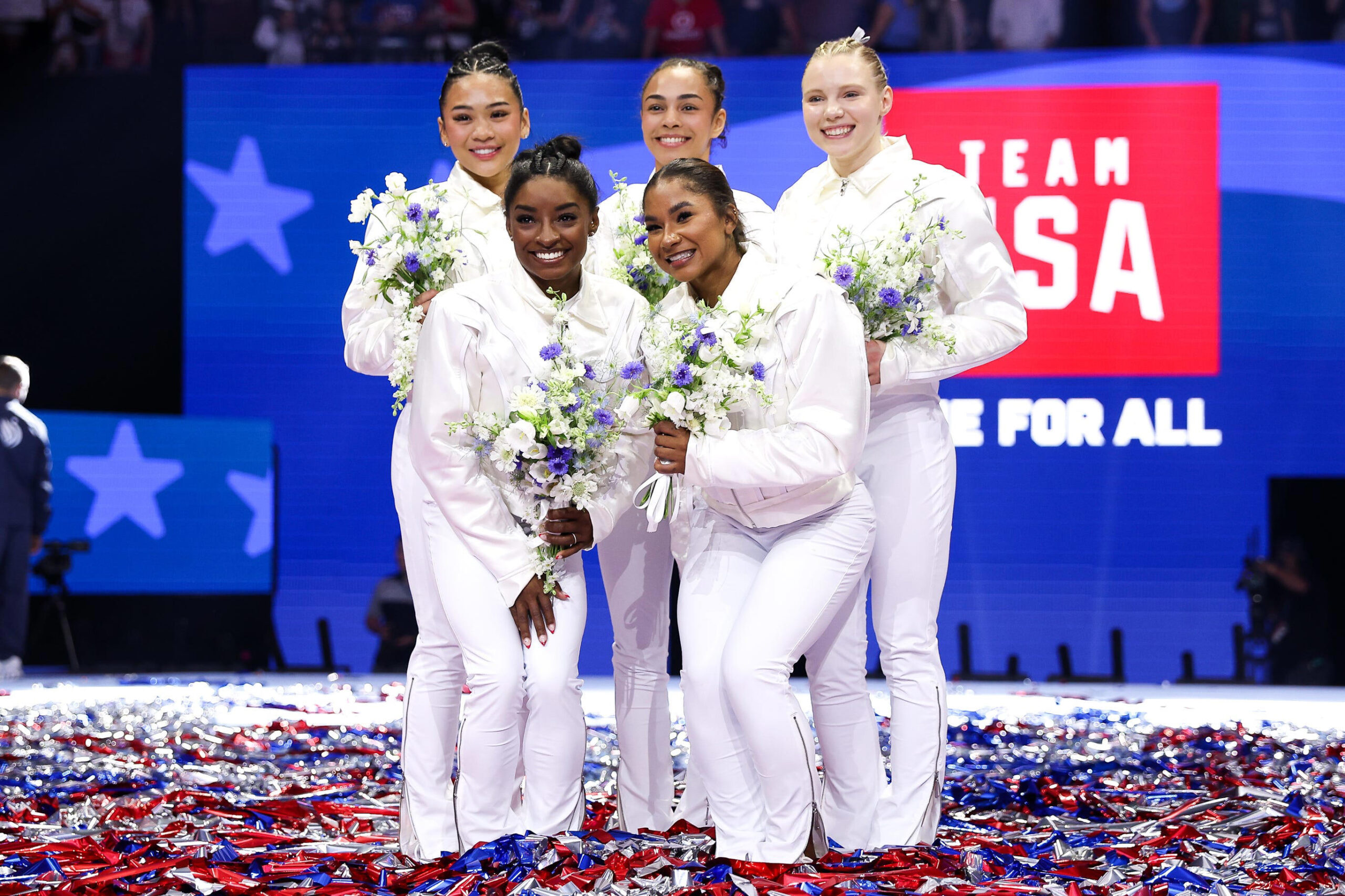By Nancy Armour
Seeing Simone Biles, Jordan Chiles, Suni Lee and Hezly Rivera playing in the confetti after US gymnastics trials in June was a powerful moment, four women of color celebrating their status as Olympians in what has traditionally been a predominantly white sport.
Less than two weeks later, Talladega College announced it was dropping its women’s gymnastics program after just one season because of a lack of resources, leaving Fisk University as the only HBCU school with a team.
The contrast between these two events represents the challenge gymnastics faces. Elite gymnastics, the national team in particular, has become a model of representation and inspiration while diversity elsewhere in the sport remains harder to sustain, if not elusive.
But there is hope that just as Biles, Lee, Gabby Douglas and Dominique Dawes sparked interest from little girls of color, this generation of athletes — and the prospect of an Olympics in Los Angeles in four years — will do the same among community leaders and decision makers.
“We need more programs in more diverse areas,” said Derrin Moore, founder of Brown Girls Do Gymnastics. “We already have the parents and the kids who say, ‘I want to do the same thing Simone did!’” Moore said. “Now it’s the city officials or (community groups). The people who can write checks are now starting to see it, and I think it’s affecting it on that level.”
Paris will be the third Olympics for Biles, who is now one of the most recognizable athletes in the world. She’s redefined her sport and rewritten its record books over the last decade-plus, putting a sledgehammer to the idea that gymnastics isn’t a sport for people of color.
As great an impact as Biles has, though, she is at the top of what has been a rising wave in US gymnastics. She, Douglas and Lee, the last three Olympic all-around champions, are all women of color. Since 1992, every US women’s team but one has had at least two athletes of color.
In Paris, four-fifths of the women’s team that is heavily favored to win gold are people of color, as are Frederick Richard and Asher Hong on the US Olympic men’s gymnastics team.
Quite the change from when Biles was growing up, and mother Nellie recalled her two daughters and one of Biles’ best friends often being the only girls of color in the gym and at competitions. Now the World Champions Centre, owned by Nellie and Ron Biles, champions diversity while developing winners.
“When a girl, it doesn’t matter what her ethnicity is, sees someone they can relate to on the television screen, they say, ‘I want to be just like her,’” Nellie Biles said. “I think the diversity is getting broader simply because there are Simones that people can relate to. More and more Black girls are in the sport. More and more Asian girls and Hispanic girls are in the sport.
“It’s very good for the sport.”
Yet gymnastics overall remains overwhelmingly white. Most coaches are white. Same for judges. In USA Gymnastics’ most recent survey of its members, 60% identified as white while less than 14% identified as Black (4.53%), Hispanic (5.15%) or Asian (3.09%); 7.46% identified as two or more races.
Roughly 19% of the respondents either left the question blank or said they were choosing not to answer, but the numbers are similar to a survey ahead of the Tokyo Olympics.
This isn’t because people of color aren’t interested in the sport. After every Olympics, Moore said, she’ll hear from people who want to know how they can get their daughters involved in gymnastics. Her group is now planning to start Brown Boys Do Gymnastics because of demand.
But interest alone isn’t enough.
Because most gyms are located in suburban areas, accessibility is an issue. Moore’s group is trying to encourage community-based organizations to add even intro-level gymnastics programs so kids, and their parents, can decide whether this is something they really want to pursue.
Even at the lower level, gymnastics is not an inexpensive sport, making cost an issue, too. Hostile or indifferent atmospheres are also a turn-off, Moore said.
“People will reach out and say, ‘Hey, I want to get my daughter involved in gymnastics, where do I go?’” Moore said. “Then the conversation becomes, ‘It costs $175 a month’ or ‘It’s too far’ or ‘My daughter doesn’t feel like she’s getting the attention,’ and they’re not doing it anymore.
“The interest comes about, but it just doesn’t stick for whatever reason.”
That has a trickle-up effect. If there are fewer gymnasts of color in high school and college programs, schools like Talladega see the gymnastics team as expendable. Talladega supporters have launched a fundraising campaign to try save the program, and BGDG is using its annual conference that begins Thursday in Atlanta to amplify the message.
If kids of color leave the sport early, or never have the chance to start gymnastics in the first place, it also means they probably won’t become coaches. Or judges.
But given the chance and the support, gymnasts of color can do anything in the sport they want. Just look at the Olympic team.
“It is exactly what it should have been all along,” Moore said. “If you have a team that for years is all white and you walk down the street and that’s not what you see, something’s wrong. You may not know where, but something’s wrong. We had to break down barriers when it should have been normal.”
Interest in the sport is there, thanks to Biles, Douglas, Dawes, Lee and so many others. Now the access must follow.





